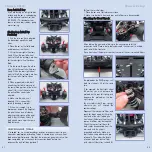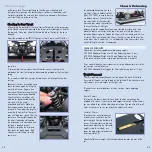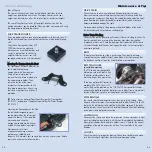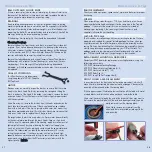
•• O
Ouutteerr ppoossiittiioonn #
#33: More stable, less traction.
•• M
Miiddddllee ppoossiittiioonn #
#22: Optimum position for most tracks.
•• IInnnneerr ppoossiittiioonn #
#11: More traction, less stability.
Initial Setting:
Front camber link: Middle position #2
A
Ad
djju
ussttiin
ng
g R
Re
ea
arr C
Ca
am
mb
be
err
Adjust rear camber using the rear
upper camber link.
•• SShhoorrtteerr lliinnkk:: More negative camber.
•• LLoonnggeerr lliinnkk:: Less negative camber.
Initial Setting:
Rear camber: -1.5° (tops of rear
wheels leaning inwards)
R
Re
ea
arr C
Ca
am
mb
be
err LLiin
nk
k P
Po
ossiittiio
on
n
The position and length of the rear
camber link affects the car’s roll
center, which affects rear traction. In
general, the longer the link, the
more rear traction there is. The rear
uprights provide two camber link
positions. Switching from one
position to the other requires
lengthening or shortening of the
rear upper camber links to maintain
an appropriate driving camber
angle.
•• O
Ouutteerr ppoossiittiioonn #
#22: More traction, less stability.
•• IInnnneerr ppoossiittiioonn #
#11: More stable, less traction.
Initial Setting:
Rear upper camber link: Inner position #1
CASTER
Caster describes the angle of the
C-hub block with respect to a line
perpendicular to the ground. Caster
angle affects on- and off-power
steering, as it will tilt the chassis
more or less depending on how
much caster is applied.
•• LLeessss ccaasstteerr (more vertical):
Increases OFF-power steering
INTO a corner, but decreases
straight-line stability.
•• M
Moorree ccaasstteerr (more laid-down): Increases ON-power steering OUT OF a
corner, and increases straight-line stability, but makes the car harder to turn
into a corner. It also makes the car more stable through bumpy track
conditions.
Chassis Setup
CAMBER
Camber is the angle of the wheels
relative to the ground when looked
at from the front or back.
•• N
Neeggaattiivvee ccaam
mbbeerr:: The tire leans
inward at the top.
•• PPoossiittiivvee ccaam
mbbeerr:: The tire leans
outward at the top.
Camber affects the car's traction. In general, more negative camber means
increased grip since the side-traction of the wheel increases. Do not use
more than -2.5° camber, and NEVER use positive camber.
The amount of front camber required
to maintain the maximum contact
patch largely depends on the amount
of caster. Higher degrees of caster
require little or no camber, while
lower degrees of caster require more
negative camber.
Perform these initial steps:
1. Remove wheels.
2. Put the car on the
Hudy Set-Up System.
3. Press down the suspension of the
car a few times to let the suspension
settle.
A
Ad
djju
ussttiin
ng
g F
Frro
on
ntt C
Ca
am
mb
be
err
Adjust front camber using the front
upper camber link.
• SShhoorrtteerr lliinnkk:: More negative
camber.
• LLoonnggeerr lliinnkk:: Less negative camber.
Initial Setting:
Front camber: -1.0° (tops of front wheels
leaning inward)
F
Frro
on
ntt C
Ca
am
mb
be
err LLiin
nk
k P
Po
ossiittiio
on
n
The position and length of the front
upper camber link affects the car’s
roll center, which affects front
traction. In general, the steeper the
angle of the camber link, the more
front traction there is. The front
shock tower provides three different
camber link positions, some of
which require lengthening or
shortening of the front upper
camber links to maintain an
appropriate driving camber angle.
NOTE: Always use the same link positions on both sides of the car.
Chassis Setup
23
CAMBER
+
-
1
1
2
3
2
CASTER
24
Summary of Contents for T1R Raycer
Page 1: ......




















